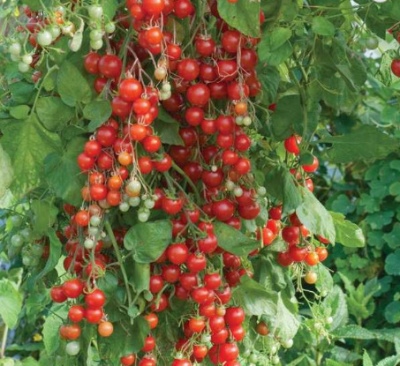
- Authors: France
- Category: grade
- Growth type: indeterminate
- Appointment: fresh consumption, for whole fruit preservation
- Ripening period: early
- Ripening time, days: 95-110
- Growing conditions: for open ground, for film greenhouses, for balconies, for growing on a windowsill, pot culture, decorative gardening
- Bush size: tall
- Bush height, cm: up to 200
- Ripe fruit color: pink
Fruit crops of French selection are not the most frequent guests in domestic gardens. Tomato Cherry Falls confirms the merits of this selection school. But success awaits only those farmers and gardeners who study the characteristics of the plant closely.
Description of the variety
Cherry Falls are among the indeterminate tomatoes. It gives high (up to 2 m) bushes. Another notable feature of this crop is the versatility of its cultivation. Such a plant can give an excellent result:
- in the open field;
- on the balcony;
- in greenhouses under a film;
- on the windowsills;
- in home pots;
- with decorative landscaping of land.
The main qualities of the fruit
Cherry tomato belongs to the cherry group. Its berries are characterized by a simple pink color. The mass of a single tomato does not exceed 0.01-0.015 kg.
Taste characteristics
You can use the crop both fresh and when canning whole berries. Its pulp is juicy enough. Consumers note the good sweetness of Cherry Falls.
Ripening and fruiting
Cherry Falls is a traditional early tomato. It ripens in an average of 95-110 days. The berries are harvested in July. The collection usually ends in the middle of autumn. Only early arrival of frosts can break this schedule.
Yield
Collection of fruits from 1 bush - at least 1000 pieces. There are up to 60 berries per 1 brush. The plant allows you to give 1.5-2.5 kg of fruit. In terms of 1 sq. m productivity is from 7 to 8 kg. Compared to other varieties of cherry tomatoes, this crop is very effective.
The timing of planting seedlings and planting in the ground
The time to sow seeds in boxes comes from March 1 to March 15. Usually the seedlings are ready to be moved to the vegetable garden between May 15th and June 5th. But actual weather can dramatically change this schedule. For seedlings, it is necessary to prepare light fertile soil mixed with sand and compost. Some sources recommend the use of peat substrates.
The sown seeds moisturize a little. Then they must be covered with a film. In some cases, glass is used instead of film. For more active germination, it is required to maintain a temperature of at least 18 and not higher than 22 degrees. The shelter is removed as soon as the seedlings hatch.

Growing tomato seedlings is an extremely important process, because it largely depends on whether the gardener can harvest at all. All aspects must be taken into account, from seedbed preparation to planting in the ground.
Landing scheme
Breeders recommend planting this variety according to the 600x500 mm system. The density is 3 or 4 bushes per 1 sq. m. This indicator depends on the formation of 1 or 2 stems. The recommended distance between bushes is 0.25-0.3 m. It is very important to use areas with good illumination.

Growing and care
Removing the stepsons of Cherry Falls is strictly mandatory. It will be impossible to do without his garter to the support. Formation is also necessary in any case.
For 1 bush, 3 liters of water are used. It is absolutely not necessary to overflow the plantings. The reference point is the drying of the soil from above.
Both organic and mineral substances are used for feeding. It is best if these are liquid mixtures - they are more actively absorbed. For Cherry Falls, late blight can be dangerous. When a threat of such an infection appears, they resort to preventive treatments with Bordeaux liquid or copper sulfate. The infection itself can be eliminated with the help of "Fundazol" or "Orphan".
The soil must be loosened. It is necessary to carefully monitor that it is not overly compacted, and immediately take action. Store-bought substrates can be used to grow mature, mature plants. If you use ordinary garden soil, then it is best from the beds where zucchini, carrots or dill grew. For dressing, calcium nitrate and magnesium sulfate are used in turn.




A plant needs different micronutrients at each stage of growth. All fertilizers can be divided into two groups: mineral and organic. Folk remedies are often used: iodine, yeast, bird droppings, eggshells.
It is important to observe the rate and period of feeding. This also applies to folk remedies and organic fertilizers.


Resistant to adverse weather conditions
It is officially stated that this tomato is capable of surviving dramatic meteorological changes. However, in the event of a cold snap, it is advised to cover it. The possibility of complete or partial freezing of an undisguised culture cannot be ruled out.

























































































